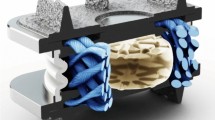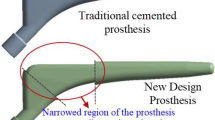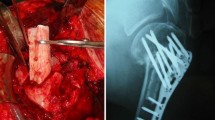Abstract
Purpose
The load-bearing pattern of periprosthetic bone may differ between patients who underwent simultaneous bilateral and unilateral total hip arthroplasty (THA). We investigated the differences in periprosthetic bone remodeling after simultaneous bilateral total hip arthroplasty and unilateral total hip arthroplasty.
Methods
This retrospective cohort study enrolled 154 consecutive patients undergoing THA using full hydroxyapatite (HA) compaction short stems. Patient characteristics including age, body mass index, University of California Los Angeles (UCLA) activity score, and bone shape of the proximal femur were adjusted by propensity score matching. Subsequently, periprosthetic bone mineral density changes were compared between simultaneous bilateral and unilateral THA.
Results
We found that bone mineral density loss in the simultaneous bilateral THA group was significantly higher in zones 6 and 7 at 24 months after THA (zone 6, p = 0.019; zone 7, p = 0.041). Periprosthetic bone mineral density loss was not associated with clinical factors, including age, body mass index, and daily activity. Additionally, we demonstrated that periprosthetic bone mineral density loss was higher in zones 1, 4, 6, and 7 of patients with a normal hip on the contralateral side after unilateral THA (zone 1, p = 0.041; zone 4, p = 0.041; zone 6, p = 0.037; zone7, p = 0.019).
Conclusions
The postoperative periprosthetic bone remodeling was lower in patients who underwent simultaneous bilateral THA than in those who underwent unilateral THA, even though patient characteristics were adjusted by propensity matching. Further observation of periprosthetic bone mineral density loss is needed to clarify the differences between the groups.

Similar content being viewed by others
Data availability
All data generated or analyzed during this study are included in this published article.
Abbreviations
- THA:
-
Total hip arthroplasty
- BMD:
-
Bone mineral density
- BMI:
-
Body mass index
- DEXA:
-
Dual-energy X-ray absorptiometry
- UCLA:
-
University of California Los Angeles
References
Harris WH (2009) The first 50 years of total hip arthroplasty: lessons learned. Clin Orthop Relat Res 467:28–31. https://doi.org/10.1007/s11999-008-0467-1
Ritter MA, Carr K, Herbst SA, Eizember LE, Keating EM, Faris PM, Meding JB (1996) Outcome of the contralateral hip following total hip arthroplasty for osteoarthritis. J Arthroplasty 11:242–246. https://doi.org/10.1016/s0883-5403(96)80073-8
Kim YH (2002) Bilateral cemented and cementless total hip arthroplasty. J Arthroplasty 17:434–440. https://doi.org/10.1054/arth.2002.31073
Schafer M, Elke R, Young JR, Gancs P, Kindler CH (2005) Safety of one-stage bilateral hip and knee arthroplasties under regional anaesthesia and routine anaesthetic monitoring. J Bone Joint Surg Br 87:1134–1139. https://doi.org/10.1302/0301-620X.87B8.16207
Stavrakis AI, SooHoo NF, Lieberman JR (2015) Bilateral total hip arthroplasty has similar complication rates to unilateral total hip arthroplasty. J Arthroplasty 30:1211–1214. https://doi.org/10.1016/j.arth.2015.02.015
Parvizi J, Tarity TD, Sheikh E, Sharkey PF, Hozack WJ, Rothman RH (2006) Bilateral total hip arthroplasty: one-stage versus two-stage procedures. Clin Orthop Relat Res 453:137–141. https://doi.org/10.1097/01.blo.0000246529.14135.2b
Alfaro-Adrian J, Bayona F, Rech JA, Murray DW (1999) One- or two-stage bilateral total hip replacement. J Arthroplasty 14:439–445. https://doi.org/10.1016/s0883-5403(99)90099-2
Reuben JD, Meyers SJ, Cox DD, Elliott M, Watson M, Shim SD (1998) Cost comparison between bilateral simultaneous, staged, and unilateral total joint arthroplasty. J Arthroplasty 13:172–179. https://doi.org/10.1016/s0883-5403(98)90095-x
Berend KR, Lombardi AV Jr, Adams JB (2007) Simultaneous vs staged cementless bilateral total hip arthroplasty: perioperative risk comparison. J Arthroplasty 22:111–115. https://doi.org/10.1016/j.arth.2007.03.043
Ritter MA, Stringer EA (1980) Bilateral total hip arthroplasty: a single procedure. Clin Orthop Relat Res 149:185–190
Shao H, Chen CL, Maltenfort MG, Restrepo C, Rothman RH, Chen AF (2017) Bilateral total hip arthroplasty: 1-stage or 2-stage? A meta-analysis. J Arthroplasty 32:689–695. https://doi.org/10.1016/j.arth.2016.09.022
Mulholland SJ, Wyss UP (2001) Activities of daily living in non-Western cultures: range of motion requirements for hip and knee joint implants. Int J Rehabil Res 24:191–198
Huiskes R (1990) The various stress patterns of press-fit, ingrown, and cemented femoral stems. Clin Orthop Relat Res 261:27–38
Burchard R, Graw JA, Soost C, Schmitt J (2023) Stress shielding effect after total hip arthroplasty varies between combinations of stem design and stiffness-a comparing biomechanical finite element analysis. Int Orthop. Online a head of print. https://doi.org/10.1007/s00264-023-05825-7
Furnes O, Lie SA, Espehaug B, Vollset SE, Engesaeter LB, Havelin LI (2001) Hip disease and the prognosis of total hip replacements. A review of 53,698 primary total hip replacements reported to the Norwegian Arthroplasty Register 1987-99. J Bone Joint Surg Br 83:579–586
Kroger H, Venesmaa P, Jurvelin J, Miettinen H, Suomalainen O, Alhava E (1998) Bone density at the proximal femur after total hip arthroplasty. Clin Orthop Relat Res 352:66–74
Anderl C, Mattiassich G, Ortmaier R, Steinmair M, Hochreiter J (2020) Peri-acetabular bone remodelling after uncemented total hip arthroplasty with monoblock press-fit cups: an observational study. BMC Musculoskelet Disord 21:652. https://doi.org/10.1186/s12891-020-03675-7
Gislason MK, Lupidio F, Jonsson H Jr, Cristofolini L, Esposito L, Bifulco P, Fraldi M, Gargiulo P (2020) Three dimensional bone mineral density changes in the femur over 1 year in primary total hip arthroplasty patients. Clin Biomech (Bristol, Avon) 78:105092. https://doi.org/10.1016/j.clinbiomech.2020.105092
Hayashi S, Hashimoto S, Kuroda Y, Nakano N, Matsumoto T, Kamenaga T, Niikura T, Kuroda R (2022) Hydroxyapatite-coated compaction short stem represents a characteristic pattern of peri-prosthetic bone remodelling after total hip arthroplasty. Arch Orthop Trauma Surg 142:2903–2910. https://doi.org/10.1007/s00402-021-04140-3
Hayashi S, Kuroda Y, Nakano N, Matsumoto T, Kamenaga T, Maeda T, Niikura T, Kuroda R (2022) Peri-prosthetic bone remodeling of hydroxyapatite-coated compaction short stem was not affected by stem alignment. J Orthop Surg Res 17:131. https://doi.org/10.1186/s13018-022-03022-7
Falez F, Papalia M, Granata G, Longo D, Ciompi A, Casella F, Mazzotta G, Favetti F (2020) Bone remodelling and integration of two different types of short stem: a dual-energy X-ray - absorptiometry study. Int Orthop 44:839–846. https://doi.org/10.1007/s00264-020-04545-6
Hochreiter J, Mattiassich G, Ortmaier R, Steinmair M, Anderl C (2020) Femoral bone remodeling after short-stem total hip arthroplasty: a prospective densitometric study. Int Orthop 44:753–759. https://doi.org/10.1007/s00264-020-04486-0
Gruen TA, McNeice GM, Amstutz HC (1979) “Modes of failure” of cemented stem-type femoral components: a radiographic analysis of loosening. Clin Orthop Relat Res 141:17–27
Rosenbaum PR, Rubin DB (1983) The central role of the propensity score in observational studies for causal effects. Biometrika 70:41–55
Koyano G, Jinno T, Koga D, Yamauchi Y, Muneta T, Okawa A (2017) Comparison of bone remodeling between an anatomic short stem and a straight stem in 1-stage bilateral total hip arthroplasty. J Arthroplasty 32:594–600. https://doi.org/10.1016/j.arth.2016.07.016
Hirao M, Miyatake K, Koga D, Takada R, Koyano G, Okawa A, Jinno T (2021) Comparison of 5-year postoperative results between standard-length stems and short stems in one-stage bilateral total hip arthroplasty: a randomized controlled trial. Eur J Orthop Surg Traumatol 31:743–753. https://doi.org/10.1007/s00590-020-02828-7
Goerres GW, Hauselmann HJ, Seifert B, Michel BA, Uebelhart D (2005) Patients with knee osteoarthritis have lower total hip bone mineral density in the symptomatic leg than in the contralateral hip. J Clin Densitom 8:484–487. https://doi.org/10.1385/jcd:8:4:484
Bryan JM, Sumner DR, Hurwitz DE, Tompkins GS, Andriacchi TP, Galante JO (1996) Altered load history affects periprosthetic bone loss following cementless total hip arthroplasty. J Orthop Res 14:762–768. https://doi.org/10.1002/jor.1100140513
Author information
Authors and Affiliations
Contributions
SH participated in the study design, drafting of the manuscript, and data collection. YK carried out data collection and drafting of the manuscript. NN participated in the data collection and drafting of the manuscript. TM participated in the study design and helped to revise the manuscript. ST participated in the data collection and drafting of the manuscript. RK participated in the study design and helped to revise the manuscript. All authors read and approved the final manuscript.
Corresponding author
Ethics declarations
Ethics approval
The study protocol was approved by our institutional ethics committee on September 8, 2011 (No 1219).
Consent to participate
Informed consent for participation in the study was obtained from all participants. The study protocol was approved by the Institutional Review Board on September 8, 2011 (No. 1220).
Consent to publish
Not applicable.
Competing interests
The authors declare no competing interests.
Additional information
Publisher’s note
Springer Nature remains neutral with regard to jurisdictional claims in published maps and institutional affiliations.
Rights and permissions
Springer Nature or its licensor (e.g. a society or other partner) holds exclusive rights to this article under a publishing agreement with the author(s) or other rightsholder(s); author self-archiving of the accepted manuscript version of this article is solely governed by the terms of such publishing agreement and applicable law.
About this article
Cite this article
Hayashi, S., Kuroda, Y., Nakano, N. et al. Comparison study of periprosthetic bone remodeling between simultaneous bilateral total hip arthroplasty and unilateral total hip arthroplasty: a matched cohort study. International Orthopaedics (SICOT) 47, 2767–2772 (2023). https://doi.org/10.1007/s00264-023-05918-3
Received:
Accepted:
Published:
Issue Date:
DOI: https://doi.org/10.1007/s00264-023-05918-3




